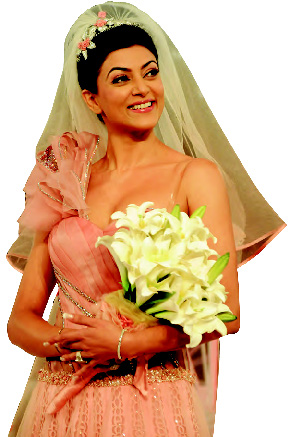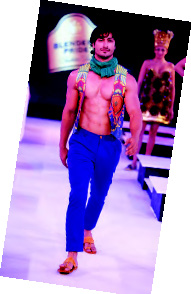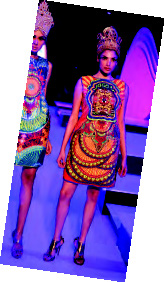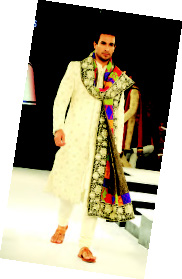
Devi~Diva Design~Darshans
A highlight of this Season of the Goddess in Gurgaon was a prismatic promenade of Devi-Diva Design-Darshans on the catwalk, at the Leela Kempinski. Gurgaonites with an aesthetic and cultivated eye were delighted by the 'live' descent upon the dais of quite a few daring diva-damsels from the drama-factories of Mumbai, projecting the most recent designs of sixteen of India's most creative couturiers. Haute-couture has been elevated to the ranks of an aesthetic form primarily by the ecoles of Europe, ever since its rapid evolution since the late 19th century. The aesthetic relevance, and historic influence, of all fine design, evolved textiles and sartorial embellishments have now found their niche in the world's best museums, as credible and accurate creative expressions of any epoch.
A heightened awareness of couture, art-decoratif and design as credible, influential art-forms gained urban relevance and flourished during the 19th-c Parisian and British Art-Nouveau movements – under the benedictions of such cutting-edge artists as Toulouse-Lautrec, Klimt and William Morris, who actively patronised and employed the decorative arts. Similarly, in India, which is a major seat of the world's design and aesthetic skills, such influential cultural institutions as Tagore's Kala Bhavana, Rukmini Devi Arundale's Kalakshetra, and the fine art schools of Baroda and Ahmedabad extended their courses and research and analysis facilities to the aesthetic realms of design and textiles. As an aesthetic barometer of different cultures, employing the commendable hand-craft skills of mastercrafts-ateliers, the Design and Couture-genre has gained artistic credibility within discerning circles of aesthetes and advanced studio and gallery circuits – thus extending the range of Art from painting and sculpture to all facets of evolved design.



Taking its cue from Fine Art, the fast-evolving genre of haute couture incorporates colour-palettes along with originality of form, texture, drama, silhouette, and high benchmarks of the beautiful – expressing individual style with a cultural fusion, that becomes a sociological leitmotif of our prevalent milieus. High fashion is hence no longer viewed as mere 'clothing,' but a form of aesthetic-cultural expression. Effective designers are now expected to extend sartorial language to genuinely creative heights. Most designers emerge from a painterly or artistic background, and an essential aspect of design-training is an intensive study of Art History. Hence, many significant painters, from Matisse, William Morris, Picasso and Husain have also painted upon textiles and saris, designed jewellery and artefacts, and extended their skills to the realms of art-decoratif.
India's finest couturiers have, of late, earned a laudable international reputation, as design-artists of commendable imagination, skill and global influence. The 8th edition of Blenders Pride Fashion Tour 2012, that took place in Gurgaon on October 20 and 21, will be held in six Indian cities from September to November – from Chandigarh to Mumbai, Kolkata, Bangalore and Hyderabad. Stylishly showcasing sixteen of India's most promising designers, from the Goan Wendell Rodricks and the Rajput Raghavendra Rathore to Shantanu and Nikhil, Gaviin Miguel, Ashish Soni, Pankaj and Nidhi, Nida Mahmood, Neeta Lulla, Nandita Mahtani, Mandira Wirk, and Phalguni-Shane Peacock, the Event is a design extravaganza.
The BPFT catch-phrase was "confidence and attitude, making the world a stylish place." In this context, the Minimalist line of Wendell Rodricks exemplifies stylish design understatement. From the aesthetic point of view, Wendell's latest couture-range echoes the stark colour-fields of the European Modernist Piet Mondrian. Working from a remote Goan village and incorporating India's fine handwoven skills, Wendell has described his humble beginnings and entry into the world of the haut-monde in his recent 2012 autobiography 'The Green Room.'
Splashes of Indian jewel-tones, like festive yellow, spiritual saffron, chilli-red and rani-pink, in modernist geometric panels on deep black, created graceful and dramatic contemporary silhouettes. From subtle tunics with in-built simulated dupattas, to radical long gowns in desi yellows and reds, none of Wendell's creations struck an awkward or discordant note. It was to the credit of some of India's leading models and choreographers that they could project the designs with understatement, ebullience and panache – that is so essential to evoke stylistics on the ramp. Wendell's couture has been displayed at such serious platforms as IGEDO and Paris' Salon Pret-a-Porter.
What is couture, however, without a Diva-Devi to carry it? Stemming from the Latin and Italian, 'Diva' literally means 'Goddess'. The presence on the ramp of two such Bengali divas, Sushmita Sen and Bipasha Basu, added a certain Sapphic splendour to this sartorial soiree. Bipasha's appearance in a glimmering Nandita Mahtani neon-green chiffon gown, in Romanesque mode, conveyed international elegance – heightened by subtle Indian metallic embroidery. Mahtani's stylistic is tasteful; not over-the-top, despite her Bollywood clientele. A feminine palette, which could have descended into confectionery-tones, was redeemed by the elegance of her drapes, that effectively conveyed an
Eastern aesthetic.
The next diva emerged preening in pink, with a permanent smile -- our own Ms. Universe Sushmita Sen, in a bridal gown, ready to fling her peachy bouquet at an astounded audience member. The trouble with Mandira Wirk's collection, titled 'Veils Unveiled,' is its over-ruffled Victorian look. Of course, there is no accounting for tastes, as such effulgently-flashy frocks do find buyers. A huge amount of Indian handworked kaarigari goes into such designs, which should rightfully retain the essence of the Indian design-aesthetic.
Bollywood designer Vikram Phadnis presented desi versions of fantasy-fashion in his intricately-wrought formal saris, ghagras, angarkhas, anarkalis and achkans. The topees worn with every outfit looked incongruous, however, as a contrast to the glittering durbari embellishments. The intricate handwork of authentic Zardozi embroidery and detailing, upon luminous and incandescent traditional khandaani textiles such as velvet, silk, brocade and georgette, redeemed a range that appeared decadent. Actress Malaika Khan as model was a fitting USP to Phadnis's tinselly theatrics in jhik-mik regalia. By contrast, Phadnis' formal male range, of ivory textured brocade achkans, highlighted with colourfully-appliqued flamboyant shawls, stood out. This striking range presents a far more aesthetic and viable option to the stiff western suits and ties, as formal wear for men – both in the east and west.
While our emerging designers can certainly stretch their visual imaginations further with even more radical experimentations, there is much potential in India's current couture textures, prints and silhouettes. Shantanu and Nikhil, Neeta Lulla and Nida Mahmood are producing interesting and sophisticated urban designs, incorporating unexpected prints and edgy forms. The Show was overall an absorbing and effective visual experience, for which due credit must also be given to the choreographer Alison Woodham, and the makeup artist Ambika Pillai, for maintaining a high international standard. The musical score was, however, cheesy and repetitive. Greater analysis and research will produce more evolved design-events, that can educate and heighten the public's sartorial sensibilities.
A final word of caution: as a note of essential social responsibility. Sponsors of high-profile Indian fashion presentations should also involve responsible Crafts, Research and Historical foundations from our own country. Indian high fashion needs to be seriously associated with social commitment, and an awareness of heritage, ethics and responsibility.
Read More...